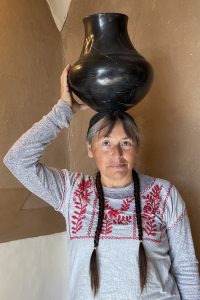
Roxanne Swentzell was a young mother on a small piece of land at Santa Clara Pueblo when she was introduced to permaculture design principles––which dovetailed with her indigenous patterns of thinking and land use. She turned her yard from hard, sun-scorched earth into an agroforest that provides food, wood, fiber and habitat. She founded the Flowering Tree Permaculture Institute, which focuses on teaching principles and practices of desert gardening, composting, seed saving, animal husbandry, beekeeping, building, and maintaining cultural knowledge–based on principles of integrity, love, reciprocity, communication, work, and consideration.
This episode is part of the Southwestern Tribal Agroforestry Outreach Project, focused on highlighting Indigenous-led agroforestry projects in the Southwest with the goal of supporting current and future Indigenous-led agroforestry efforts, and the general public. Stay tuned for the release of other project materials including videos, info sheets, a synthesis and webinars! Podcast episode was made possible by a grant from the U.S. Department of Agriculture (USDA), Forest Service, National Agroforestry Center, under the authority of the Cooperative Forestry Assistance Act of 1978. USDA is an equal opportunity provider, employer, and lender.
3’30 how she started building her house and garden
5’41 the idea of a permaculture food forest
6’59 pattern understanding concept in permaculture, which resonated with her pueblo background
8’41 placing a rock in the yard to create a microclimate
11’10 planted a tree on the northeast side of the rock, and the rock acted as a mother for the tree
12’37 added black locust tree as a nitrogen fixer, good wood, and animal feed
13’00 also brought in Siberian pea shrub
13’46 thinking about invasive/non-native species
14’25 using plants that are adapted to this climate, but also hardy speces from other places that produce food
14’58 seeing whether species act like colonizers or if they get along with the other plants already there
15’57 cheat grass acts like an invasive colonizer plant
17’42 how to listen to the land and hear what it’s telling you
18’57 thinking of her relationship to the land as a love story
20’04 Start
23’08 within six years they had a fruitful garden oasis on the land, and the 1/8 acre supported a family of four
24’14 the succession of plants over three decades
25’32 growing bamboo in the desert–it took 20 years to take off and flourish
28’06 the intersection between permaculture design and indigenous traditions she grew up with–balance and regeneration
30’25 how the Flowering Tree Permaculture Institute began
32’22 all kinds of animals and birds on the land
33’40 her children’s reaction to this process
34’51 self-sufficiency a goal but not fully realized
36’28 other Flowering Tree Permaculture projects
38’20 cultural survival–foods crafts language building language practices
40’50 seed saving
42’44 developing a sense of place over a long time, a sense of belonging
46’54 the earth is screaming to be heard
48’30 the difference between jumping outside yourself and going within yourself
50’00 thinking about food even in cities and small places
51’39 the more things we do for ourselves the more we’re taking power back from corporations
53’24 not knowing the stories behind your food when you buy it in a supermarket
54’09 connecting permaculture and her art
This episode is part of the Southwestern Tribal Agroforestry Outreach Project, focused on highlighting Indigenous-led agroforestry projects in the Southwest with the goal of supporting current and future Indigenous-led agroforestry efforts, and the general public. Stay tuned for the release of other project materials including videos, info sheets, a synthesis and webinars! Podcast episode was made possible by a grant from the U.S. Department of Agriculture (USDA), Forest Service, National Agroforestry Center, under the authority of the Cooperative Forestry Assistance Act of 1978. USDA is an equal opportunity provider, employer, and lender.



Subscribe:
Apple Podcasts
Spotify